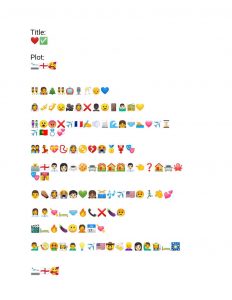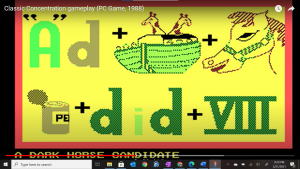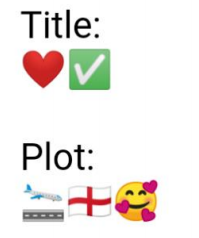
Before I dive into discussing this task, I must warn that there are likely to be some unintentional spoilers. Therefore, I highly recommend that anyone reading this ensures that they have already viewed my emoji story and have made their own educated guess as to which popular work I decided to encode in emojis. With that said, I can now delve into the process behind the result.
Admittedly, I cherry-picked the work based on how easily I thought I would be able to convey the general plotlines. In this particular work, there are a series of interconnected plots that I knew would be incredibly difficult to show connections between, but which are distinct and strong enough to stand alone. My hope was that by separating them out with spacing, it would be clear that these could be considered separate entities, expressed in small enough pieces for the reader to decipher meaning. I imagined that if the reader were able to find meaning in even just one of these smaller plotlines, it would allow them to “crack the code”, not only figuring out which work I was conveying, but also seeing and appreciating the way that I expressed the other storylines (and using them as confirmation that they are in fact correct in their assumption about the work I selected). A fear I had was that readers wouldn’t know that they’re allowed to read these separate entities as such, and that there might be an assumption that everything I included was meant to be linear. Kress (2005) speaks of discernable reading paths, and I struggled with how to express that although there is some order to how the story should be read (each subplot is generally linear in how they are individually presented), there are also many entry points that could be used to gain understanding.

A screenshot from the game “Concentration”
I decided very early on with this task that I would attempt to convey ideas as much as possible with each emoji selection, instead of piecing together sets of emojis in a way as to group syllables and create words, like in the classic game show “Concentration”. The example that has always with me from the video game version of that show – which I played a lot of as a kid – included a bar, a bra, a brick wall, and some tears, which were meant to convey famed journalist “Barbara Walters”. Even with focusing on conveying ideas rather than piecing together words, it still proved to be a very difficult task. Unfortunately (for this task, at least) emojis aren’t specifically encoded to mean one particular thing, meaning they missed Bolter’s (2001) ideal standard of having the “pictorial elements reveal transparently the information that lies ‘behind’ them”. There was ambiguity with each emoji I selected. As mentioned in Zaltman (2019), some gestures aren’t universally understood to mean the same thing. With using particular emojis there was a real risk that a misinterpreted emoji might derail an entire subplot being expressed.
I ended up asking my wife to decipher the work based on my emojis, and it was interesting to hear her critiques on the emojis that I selected. For starters, they displayed differently on her device. I created mine using my android phone, composing them as a message in Gmail. She opened them on her iPhone and was presented with different versions of the emojis which changed certain elements in ways that I believe affected the message. When she suggested that certain emoji choices could be improved, it was mainly because certain elements within the emojis I selected (such as a woman swimming) detracted from the message because of their inaccuracy. In the work I selected, the characters swam in their underwear, but I couldn’t find an emoji that expressed that, and I had to settle for a clothed version. Kress (2005) spoke of gains and losses from expressing messages via different mediums, and this is definitely an example of a loss.
I think the one benefit of expressing a story entirely through emojis (as opposed to simply using words or a combination where words are included to at least provide small bits of context), is that, as Bolter (2001) mentions, speakers of different languages would have just as good of a chance of interpreting the message I’m attempting to convey. I’m also interested in now attempting to decipher what my classmates have put together, keeping in mind my own struggles. I’m hoping that by reflecting on where I feared I may detract from my message, I’ll better be able to understand what they’re attempting to convey.
References
Bolter, J. D. (2001). Writing space: Computers, hypertext, and the remediation of print. Routledge.
Kress, G. (2005). Gains and losses: New forms of texts, knowledge, and learning. Computers and Composition, 22(1), 5-22.
Zaltman, H. (Host). (2019, July 13). New Rules [Audio podcast episode]. In The Allusionist. https://www.theallusionist.org/allusionist/new-rules

James, I perused everyones emoji stories last week, and thought I got yours pretty quickly, but then did not understand the flag, so gave up. I came back to it after you guessed mine and took the extra step of Googling and learning it’s England’s flag! Perhaps its less accurate, but I would have been on it right away with the Union Jack. I’ve had that Troggs song stuck in my head since seeing this last week!
My biggest internal debate was on whether to attempt to include emojis for fingers and toes in the first portion of the plot, but the emojis available were lacking, and I figured that including a full hand and full foot would only add confusion.